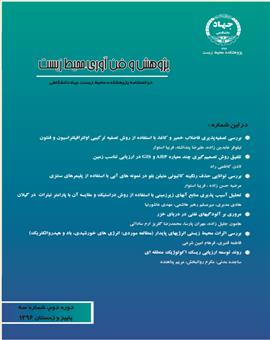تحليل آسيبپذيري منابع آبهاي زيرزميني با استفاده از روش دراستيك و مقایسه آن با پارامتر نیترات در گيلان
محورهای موضوعی : آلودگی منابع آب
کلید واژه: شاخص دراستیک آنالیز حساسیت نیترات GIS استان گیلان,
چکیده مقاله :
توسعه صنعتی، کشاورزی و افزایش جمعیت در دهه های اخیر باعث استفاده روز افزون از مواد شیمیایی، کودها و افزایش ضایعات صنعتی در بخش های مختلف و در نتیجه آلودگی منابع آب خصوصا آب های زیرزمینی شده است. اعمال یک مدیریت مناسب بر منابع آب با تعیین مناطق آسیبپذیر بهعنوان اولین راهکار می تواند مفید باشد. هدف این پژوهش ارزیابی آسیب پذیری در دشت مرکزی گیلان با مدل دراستیک بود. جهت شناسایی نواحی آسیبپذیر آبخوان دشت مرکزی گیلان در برابر آلودگی، از مدل مذکور استفاده و نقشه آسیبپذیری آبخوان تهیه شد. اصول مدل دراستیک بر پایه ترکیب هفت مولفه ی عمق تا سطح ایستابی، تغذیه خالص، محیط آبخوان، محیط خاک، توپوگرافی، محیط غیراشباع و هدایت هیدرولیکی است که پس از رتبهدهی؛ اعمال تاثیر وزنی به هر مولفه و ترکیب جبری هفت مولفه نتیجه نهایی معرف آسیبپذیری آبخوان خواهد بود. برای این کار ابتدا اطلاعات مربوط به هفت مولفه در آبخوان دشت مرکزی گیلان جمع آوری و پس از ورود به نرم افزار GIS نهایتا لایه های موردنیاز مدل تهیه گردید. سپس با استفاده از تکنیک های هم پوشانی و پس از اعمال ضرایب وزنی لازم بر هر لایه، نقشه نهایی آسیبپذیری منطقه تهیه گردید. نمایه حاصل از مدل دراستیک بین 182-82 برای آسیبپذیری ابخوان دشت مرکزی گیلان متغیر بود. در این دشت آسیبپذیری خیلی کم و آسیبپذیری خیلی زیاد مشاهده نشد. نقشه نهایی مدل دراستیک نشان داد که 64/48 درصد از منطقه دارای آسیبپذیری بالا و 55/50 درصد دارای آسیبپذیری متوسط و تنها مساحت کوچکی از دشت دارای آسیبپذیری کم میباشد. نتایج حاصل از همبستگی بین مولفه های مدل دراستیک و یون نیترات نشان داد که بیشترین همبستگی بین یون نیترات و مولفهی عمق تا سطح ایستابی وجود دارد. میانگین غلظت نیترات در چاههای مورد مطالعه در دشت مرکزی گیلان برابر92/8 میلیگرم بر لیتر است.
Industrial and agricultural developments and the population of rural and communities led to excessive consumption of chemical detergents and fertilizers and increasing industrial wastwater which threaten water resources in last decades. Vulnerability of the water resources is a continuation of such trends. The first step in management of the groundwater resources is a determination of the vulnerable areas. The objective of this research was determin the vulnerability assessment of the central plain of Guilan using DRASTIC model. Principles of the model are based on overlaying of seven thematic maps of depth to water table, net recharges, aquifer media, soil media, topography, vados zone and hydraulic conductivity by considering appropriate weights and rates. The database was constructed by introducing the mentionec maps. Index of DRASTIC model for aquifer vulnerability of the central plain Guilan was ranged in 82-182. In this plain, there was not very much and very low vulnerability classes. The final map of DRASTIC model showed that % 48.64 of the area has high vulnerability and % 50.55 has medium vulnerability and only a small area of plain (% 0.81) has low vulnerability. Th estatistical summary of the DRASTIC model elements shows that the element of depth to groundwater table has the greatest impact on DRASTIC model. Also based on the map remove and single element sensitivity, depth to groundwater table is identified as the effective element in the central plain of Guilan. The results of the correlation between the elements of DRASTIC model and nitrate concenteration showed that there is the highest correlation between nitrate and depth to groundwater table. The average concentration of nitrates is 8.92 mg/lit in the wells studied at the Central Plains Guilan. In all wells studied, nitrate concentration was lower than the recommended level by US Environmental Protection Agency (45 mg/lit).
1. کردوانی، پ.، 1383، منابع و مسائل آب در ایران. موسسه انتشارات و چاپ دانشگاه تهران، 545 صفحه.
2. Babiker, I.S., Mohamed, A.A., Mohamed, H.T. and Kato, K., 2005. A GIS-based DRASTIC model for assessing aquifer vulnerability in Kakamigahara Heights, Gifu Prefecture, central workshop on vulnerability assessment. Journal of Geology and Geophysics., 14(2&3): 1147-1154.
3. Boughriba, M., Barkaoui, A., Zarhloule, Y., Lahmer, Z., El Houadi, B. and Verdoya, M., 2010. Groundwater vulnerability and risk mapping of the Angad transboundary aquifer using DRASTIC index method in GIS environment. Arabian Journal of Geosciences., 3:207–220.
4. Denny, S.C., Allen, D.M. and Journeay, J.M., 2007. DRASTIC-Fm: a modified vulnerability mapping method for structurally controlled aquifers in the southern Gulf Island, British Colombia, Canada. Hydrogeology journal., 15: 483-493.
5. Fritch, T.G., McKnight, C.L., Yelderman, J.C. and Arnold, J.C., 2000. Aquifer vulnerability assessment of the Paluxy aquifer, central Texas, USA, using GIS and modified DRASTIC approach. Journal of Environmental Management., 25: 337-345.
6. Gogu, R.C. and Dassargues, A., 2000. Current trends and future challenge in groundwater vulnerability assessment, using overlay and index methods. Journal of Environmental Geology., 39: 549-558.
7. Panagopoulos, G.p., Antonakos, A.K. and Lambrakis, N.J., 2006. Optimization of the DRASTIC method for groundwater vulnerability assessment via the use of simple statistical methods and GIS. Hydrogeology Journal., 14: 894-911.
8. Thirumalaivasan, D., Karmegam, M. and Venugopal, K., 2001. AHP- DRASTIC: software for specific aquifer vulnerability assessment using DRASTIC model and GIS. Environmental Modeling and Software., 18: 645-656.
9. Van Stempvoot, D., Evert, L. and Wassenaar, L., 1993. Aquifer vulnerability indexL a GIS compatible method for groundwater vulnerability mapping. Journal Water Resources., 18: 25-37.

